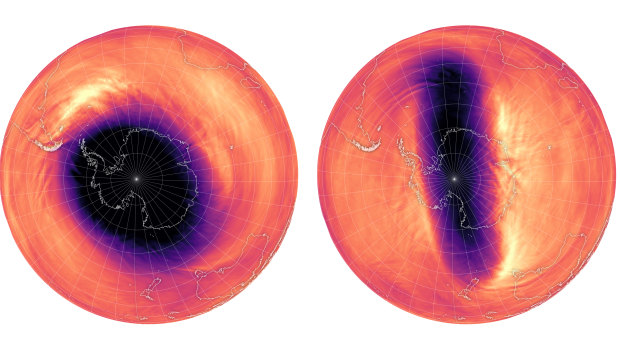
Tully, who also has a senior role at the Bureau of Meteorology, said the Montreal Protocol was signed in 1987, and tightened progressively. It took until 2000 for the ozone layer to start healing, and until 2018 for scientists to be sure of the recovery trend.
“It’s often called the most successful international environmental agreement, and it certainly shows what can be achieved if governments, scientists and industry work together,” he said.
“We still need to keep carefully monitoring ozone to make sure … it is recovering as we expected, and to keep measuring ozone-depleting substances to make sure that all countries are keeping to their commitments. In recent years there was some illegal production in China, and they were using it for styrofoam.”
The ozone hole worsened rapidly in the 1980s and 1990s, Tully said, while the recovery was much slower. It took a long time for the ozone-depleting substances to travel to the stratosphere, and they would remain and cause damage every year until they deteriorated.
At this rate, the hole is expected to recover to 1980 levels by about 2066 for the hole over Antarctica, by 2045 for the smaller hole over the Arctic, and by 2040 for the thinning over the rest of the world, including Australia.
Professor Sharon Robinson, a climate change biologist and Antarctic researcher at the University of Wollongong, warned that mega bushfires and increased space activity such as rocket launches for civilian satellites could set back the long-term recovery.
“The Montreal Protocol is an amazing treaty, and it has banned all those CFCs and also HCFCs, but there are new threats, which we need to be aware of,” Robinson said.
Why did the ozone hole form late this year?
The hole normally forms in late winter and early spring, and closes by summer. Dr Martin Jucker, an atmospheric dynamics and climatology expert at the University of NSW, explains this is because it needs to be very cold to form stratospheric polar clouds, which act as the catalyst for the chemical reactions that destroy ozone.
“If it’s warmer, there are [fewer] clouds, and therefore less ozone destruction,” Jucker said.
The Copernicus Atmosphere Monitoring Service attributed the delay to disruptions in the polar vortex, after two episodes of sudden stratospheric warming in July.
Loading
Tully said the polar vortex was a high-altitude wind - much higher even than the jet streams - that swirls above Antarctica.
“This year, in July, there was quite a disturbance to the polar vortex, and the temperature in the stratosphere jumped up by more than 15 degrees, roughly,” Tully said.
“That’s had an effect on the ozone hole this year – it got off to a slow start because of that disturbance – but the connection to weather on the ground is less clear.”
Jucker said the disturbance was probably caused by warm ocean temperatures and melting sea ice having a ripple effect in the stratosphere.
The polar vortex usually stays in a circle over Antarctica, but this year it was pushed into an elongated elliptical orbit. Jucker said the altered path took in part of Australia, and was the likely cause of the freezing, unsettled weather in the south of the continent in early August.
He noted the southern annular mode – a climate driver for rainfall and temperatures – was extremely negative at the time.

The disturbance in the stratospheric polar vortex over Antarctica in early August 2024. The colours show the air temperature at 10hPa, from less than -75 Celsius (black) to more than 35 degrees (yellow).Credit: NASA Earth Observatory
“I think there’s a relationship there,” Jucker said. “It was just a few days, but it looked like it was a reaction from the stratosphere being disturbed.”
Jucker said the stratospheric disturbances were concerning, and while it was tempting to think of the delayed ozone hole formation as a silver lining, it was only a reprieve of a few weeks and would not have a long-term benefit.
Robinson said the ozone hole normally disappeared in November, but for the past four summers in a row it had persisted into December because of bushfires and volcanic activity. This put flora and fauna at risk of sunburn because the lower ozone protection coincided with more direct UV rays and less protection from sea ice and snow cover, she said.
Loading
Associate Adjunct Professor Craig Sinclair, a skin cancer expert from Cancer Council Victoria, said Australians had the highest rates of skin cancer of almost anywhere in the world, but the ozone recovery meant this should not get worse.
Sinclair, who along with Tully is the other Australian member of the World Meteorological Organisation’s advisory group, said behavioural changes such as wearing a hat at school, meant “we’re starting to see a downturn in skin cancer rates in younger age groups”.
Get to the heart of what’s happening with climate change and the environment. Sign up for our fortnightly Environment newsletter.









 Add Category
Add Category